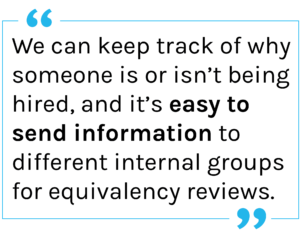HR compliance is complicated, and it’s also a vital aspect of human resources work.

In the world of HigherEd, HR compliance is often especially complex for schools dependent on state or federal budget dollars. Keeping up with requirements, keeping track of all your information, ensuring accurate historical records, and maintaining standardized hiring practices. We know this role is central to keeping your institution running. According to HR Dive, “HR professionals are the absolute front line of defense for a company to make sure it treats people fairly, legally and keeps the business out of danger.”
With so much depending on your team, what are some ways you can simplify HigherEd HR compliance? Check out top tips from some of our customers below.
Embrace digitization
Hiring for an open role can bring in massive amounts of information to your office, including sensitive candidate information as well as notes, reviews, and conversations at every stage of the hiring process. Keeping track of and sometimes reporting on all that information is vital. Vanessa Ortiz, a Human Resources Analyst at Mt. San Antonio College, mentioned how their switch to a digitized applicant system has made a huge difference.
 “It’s great to be able to see all the hiring information clearly,” says Vanessa. “We can keep track of why someone is or isn’t being hired, and it’s easy to send information to different internal groups for equivalency reviews.”
“It’s great to be able to see all the hiring information clearly,” says Vanessa. “We can keep track of why someone is or isn’t being hired, and it’s easy to send information to different internal groups for equivalency reviews.”
If your institution is pursuing cross-campus standardization of hiring practices, or is focused on diversity initiatives across departments or schools, make use of data visibility and keep track of every applicant that goes through any part of your process. Create consistent ways for your hiring managers to keep track of their decision-making, even while maintaining different hiring processes for different role types (like faculty, adjunct faculty, or staff) in your ATS.
Keep everything in one place
Hiring in HigherEd gets complex very quickly. With so many decision-makers, it can be a huge administrative burden just to keep track of a single applicant going through the hiring process—and there is often more than one applicant being interviewed.
On top of that, many institutions have multiple systems at play in their HR offices, like background check solutions. Transferring information from one system to another adds additional administrative burden and introduces the possibility of errors. Robin Borough, the Director of Talent Acquisition at Chapman University in Orange, CA, had a few tips for fellow HR leaders.
First, she noted how much time is saved within each job search at Chapman—before their digitized system, there was an unmanageable burden of paperwork as every member of a hiring committee weighed in. Now, their ATS allows all members of a committee to view and submit paperwork in one place.
Second, she recommends implementing integrations for easy reference checking. “The hiring managers used to do references offline or in email. Now, it’s one little button for them to check the references on their candidates.”
PeopleAdmin’s ATS integrates seamlessly with several background check providers, including Applya, First Advantage, HireRight, and Proforma. These connections can streamline the application process for both candidates and internal HR teams.
Ensure EEO compliance
When Alan Clay became Associate Director for Affirmative Action and Equal Opportunity at Northern Illinois University, he realized that many affirmative action principles and EEO capabilities were missing from the application and hiring workflows. That made it difficult to ensure compliance both internally, in Alan’s Affirmative Action and Equal Opportunity office, as well as to ensure and demonstrate compliance with external guidelines.
Alan advises other HR teams to examine their workflows, and not to be afraid of a complete overhaul, to make sure things are working for a modern, digitized, and multi-faceted HigherEd hiring process.
modern, digitized, and multi-faceted HigherEd hiring process.
At NIU, compliance and internal review and approval processes were previously paper-based. Now, those documents are uploaded and automatically routed for approval, meaning no information is lost in the shuffle and everyone who needs to can have visibility. Alan recommends focusing on the flexibility and customization options of your ATS so that you can make compliance work for the nuances of your institution, just as NIU has done. Read more about their overhaul!
Final thoughts
For more tips on making your system work for you, check out these customer stories. For more on HR compliance, check out CUPA-HR’s toolkits and resources.